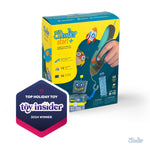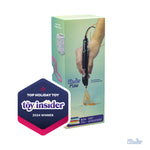As an educator, you may be asking yourself, how can I kick off the school year in the best way possible?
Well, we’ve got something special for you that will bring some social-emotional learning (SEL) and design thinking to your students in a fun and engaging way.

Icebreakers and design challenges are fantastic activities to cultivate meaningful experiences at school, both socially and academically. Why not get the best of both worlds with our back to school icebreaker design challenge?
Icebreaker Design Challenge
Materials Needed
- 3Doodler Pens (1 pen per pair of students)
- 3Doodler Filaments (5 strands per student)
- Optional: Scrap paper or cardboard and scissors to use with the filament to make the project mixed media

Instruct students to close their eyes and spend one minute reflecting on what they love about school. After the minute is up, with students’ eyes still closed, ask students to reflect on a time where a specific tool at school helped them accomplish an important goal.
Share the goal: Students will create a model of the tool that came to mind with 3Doodler pens.
Split students into groups and pass out 3Doodler pens and filaments (and paper/cardboard if you choose to use that as an additional material). Have students take turns creating their prototypes with the pens.
Circle Share: To encourage listening, have the groups position their chairs in a circle so that all students can easily make eye contact with one another. Have each student share their model and why they chose that specific tool. To facilitate empathy, encourage deeper conversation around what each student shares by asking the group, “Why did they choose that tool to prototype?” or “What point of view are they coming from?”
Extension: Have students brainstorm on how the tool that benefited them could be improved. Instruct students to modify their model to include the improvement, then repeat step 5 for circle sharing.
This activity aligns with the following ISTE Standards:
- ISTE 4C: Students develop, test and refine prototypes as part of a cyclical design process.
- ISTE 5C: Students break problems into component parts, extract key information, and develop descriptive models to understand complex systems or facilitate problem-solving.

Building strong relationships with and among your new students is foundational to creating a safe and enjoyable learning environment. In this space, students feel more trusting of their teachers and peers, and more comfortable and confident asking questions and taking risks. Check out this amazing Cult of Pedagogy article to learn more about building strong relationships with your students.
Do you love this activity? Please share your classroom prototypes with us on social media!
@3Doodler #3Doodler #3DoodlerEDU






